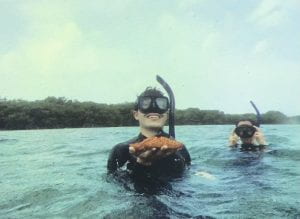Hey guys! It’s Michiel; I’m glad to write to y’all again : )
This morning I woke up and had an amazing breakfast (as always here). After breakfast, Adrienne and Scott wanted us to practice using our quadrats and transects, so they sent us out to collect some data on the island using these tools. Ava and I decided that we wanted to see how much of the island sand was disturbed by crab lines. We set up a 50 yard line from our transect, set our quadrat on either side of the transect, and counted the amount of squares covering sand that was disturbed by crab lines. We ultimately determined that about 9% of the sand in the area we studied was disturbed.
After this riveting experiment, we got to put our tools to use out on the reef! Our professors left us in the wet lab with only instructions to come up with a research question and methodology. As a class, we asked “How does the density of Penicillus green algae change as we get further from the dock?” To test this, each buddy group lined up in the water near the dock and spread out horizontally so that there was at least 10 ft of space between us. Then each of us went off, placing our quadrats at every 10 foot marking on the transect to count the number of Penicillus organisms. Unfortunately, Ava and I did not see a single one (we did see two sea anemones and a starfish, though). We also did not get to see any herbivorous fish since we stayed pretty far away from the patch reefs : (. They’re really only found over there because their diet consists mostly of algae that grows on the reef, so it would be unwise for them to go too far.
Thankfully, the other groups did find some Penicillus, so we pooled our data and determined that the organism increases in density as one goes further from the dock. We believe that Ava and I did not see any because the lush sea grass in our area may outcompete or cover it. After discussing our results, the class put together a poster and presented our research to Scott and Adrienne.
After these presentations, we went to a very cool area of the island that was just a huge fossilized coral reef. Adrienne showed us lots and lots of different, very well preserved, corals. She identified some of the most common corals we have been seeing in the reef and told us about their importance and history. She even showed us a couple species that are currently rapidly dying off in coral reefs.
After the fossilized coral area, we had a presentation, then dinner, then I presented on herbivorous fish (I hope you all enjoyed), then there were a couple more presentations.
Overall, today was full of activities and it was our first time conducting research in the water! We all had lots of fun and I’m sure we’re all excited for the upcoming days of research in bigger coral reef systems.
Also, here’s a picture Ava took of me holding a starfish (thank you Ava!)



